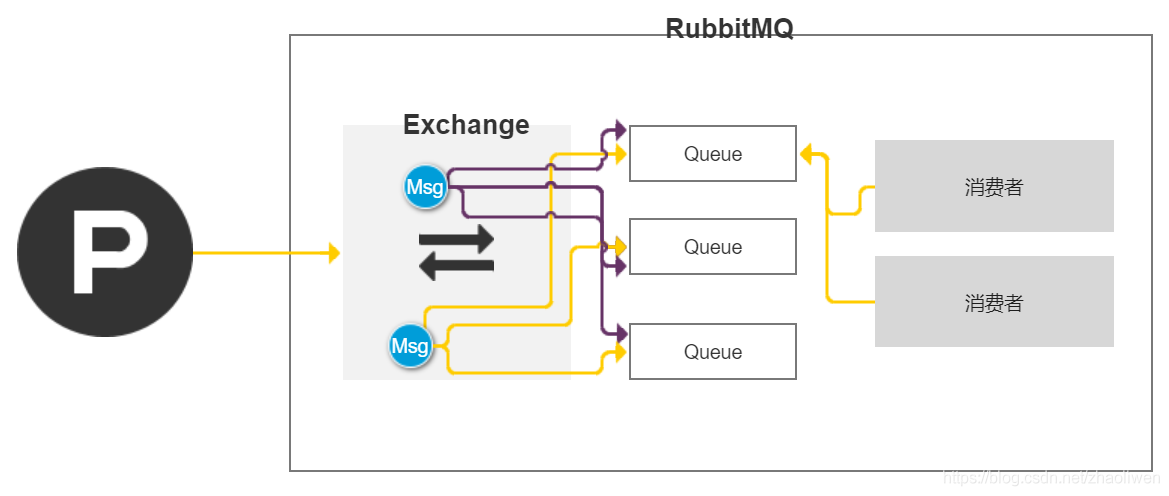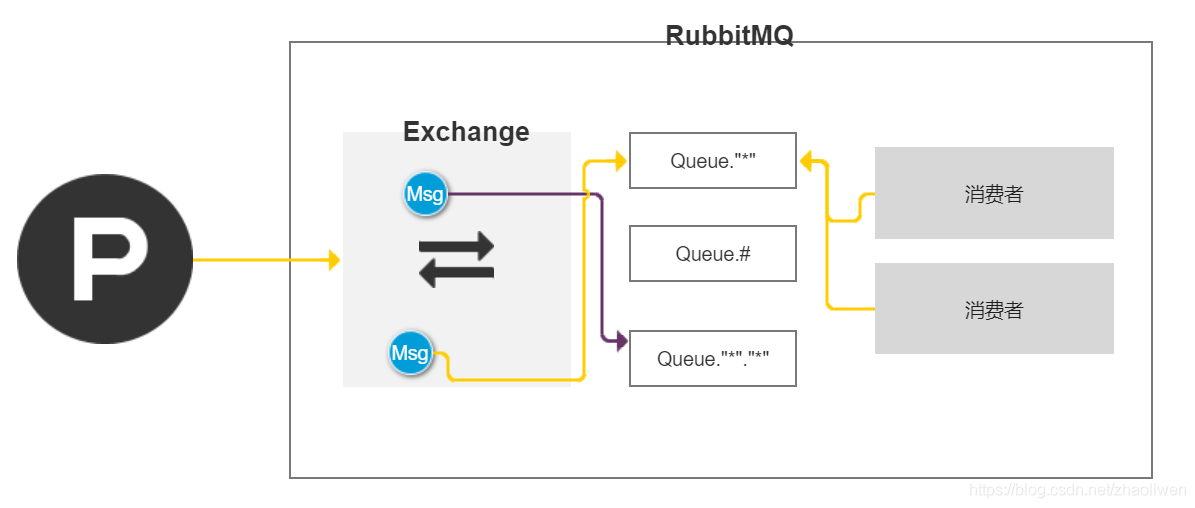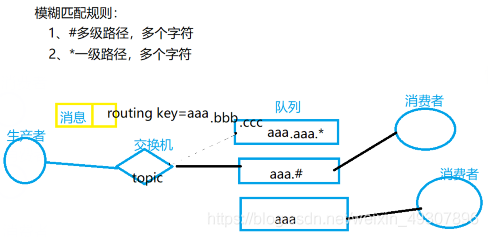RabbitMQ五种模式
1. 简单模式
当生产者发送消息到交换机,交换机根据消息属性发送到队列,消费者监听绑定队列实现消息的接收和消费逻辑编写.简单模式下,强调的一个队列queue只被一个消费者监听消费.
//定义对列名称
private final String DEMO8_QUEUE = "demo8_queue";
//定义对列名称
private final String DEMO9_QUEUE = "demo9_queue";
@Bean
public Queue queue8() {
return new Queue(DEMO8_QUEUE, true);
}
@Bean
public Queue queue9() {
return new Queue(DEMO9_QUEUE, true);
}
/**
* @Author wzj
* @Param
* @param: requestJSON
* @Description 简单模式/争抢模式
* @Date 10:55 2021/4/12
**/
@RequestMapping(value = "/demo1", method = RequestMethod.POST)
public void demo1(String requestJSON) {
Message message = null;
try {
message = MessageBuilder.withBody(requestJSON.getBytes("UTF-8")).build();
//持久化消息
message.getMessageProperties().setDeliveryMode(MessageDeliveryMode.PERSISTENT);
rabbitTemplate.convertAndSend("demo8_queue", message);
} catch (UnsupportedEncodingException e) {
e.printStackTrace();
}
}
生产者:生成消息,发送到交换机
交换机:根据消息属性,将消息发送给队列
消费者:监听这个队列,发现消息后,获取消息执行消费逻辑
应用场景:发短信、发邮件。
2. 争抢模式
强调的也是后端队列与消费者绑定的结构
//定义对列名称
private final String DEMO8_QUEUE = "demo8_queue";
//定义对列名称
private final String DEMO9_QUEUE = "demo9_queue";
@Bean
public Queue queue8() {
return new Queue(DEMO8_QUEUE, true);
}
@Bean
public Queue queue9() {
return new Queue(DEMO9_QUEUE, true);
}
/**
* @Author wzj
* @Param
* @param: requestJSON
* @Description 简单模式/争抢模式
* @Date 10:55 2021/4/12
**/
@RequestMapping(value = "/demo1", method = RequestMethod.POST)
public void demo1(String requestJSON) {
Message message = null;
try {
message = MessageBuilder.withBody(requestJSON.getBytes("UTF-8")).build();
//持久化消息
message.getMessageProperties().setDeliveryMode(MessageDeliveryMode.PERSISTENT);
rabbitTemplate.convertAndSend("demo8_queue", message);
} catch (UnsupportedEncodingException e) {
e.printStackTrace();
}
}
生产者:发送消息到交换机
交换机:根据消息属性将消息发送给队列
消费者:多个消费者,同时绑定监听一个队列,之间形成了争抢消息的效果
应用场景:抢红包,资源分配系统
3. 路由模式
前面简单模式和争抢模式,着重强调的是消费端。而路由模式,看到“路由”二字,大家也许会猜到,这个和交换机有关了。
路由模式指交换机通过消息的key将消息发送到指定的队列。
//定义交换机名称
private final String DIRECT_EXCHANGE_NAME = "directExchange";
//定义交换机名称
//配置交换器
@Bean
DirectExchange directExchange() {
return new DirectExchange(DIRECT_EXCHANGE_NAME, true, false);
}
//定义对列名称
private final String DEMO6_QUEUE = "demo6_queue";
//定义对列名称
private final String DEMO7_QUEUE = "demo7_queue";
@Bean
public Queue queue6() {
return new Queue(DEMO6_QUEUE, true);
}
@Bean
public Queue queue7() {
return new Queue(DEMO7_QUEUE, true);
}
// 绑定队列到交换器
@Bean
Binding bindingDirectExchangeQueue6(Queue queue6, DirectExchange directExchange) {
return BindingBuilder.bind(queue6).to(directExchange).with(DIRECT_KEY);
}
// 绑定队列到交换器
@Bean
Binding bindingDirectExchangeQueue7(Queue queue7, DirectExchange directExchange) {
return BindingBuilder.bind(queue7).to(directExchange).with(DIRECT_KEY);
}
/**
* @Author wzj
* @Param
* @param: requestJSON
* @Description 路由键模式
* @Date 10:55 2021/4/12
**/
@RequestMapping(value = "/demo2", method = RequestMethod.POST)
public void demo5(String requestJSON) {
Message message = null;
try {
message = MessageBuilder.withBody(requestJSON.getBytes("UTF-8")).build();
//持久化消息
message.getMessageProperties().setDeliveryMode(MessageDeliveryMode.PERSISTENT);
rabbitTemplate.convertAndSend(DIRECT_EXCHANGE_NAME, DIRECT_KEY, message);
} catch (UnsupportedEncodingException e) {
e.printStackTrace();
}
}
应用场景:
1.将手机号作为路由key ,将其发送到指定队列,由持有该手机号的客户端监听队列中的手机短信。
2.将系统的异常消息发送到指定队列,由负责日志记录的应用记录日志。
4. 发布订阅模式
这里强调的也是交换机,将受到的消息发送给多个队列,而不单单指一个。
//定义交换机名称
private final String FANOUT_EXCHANGE_NAME = "fanoutExchange";
//配置交换器
@Bean
FanoutExchange fanoutExchange() {
return new FanoutExchange(FANOUT_EXCHANGE_NAME, true, false);
}
//定义对列名称
private final String DEMO1_QUEUE = "demo1_queue";
//定义对列名称
private final String DEMO2_QUEUE = "demo2_queue";
//定义对列名称
private final String DEMO3_QUEUE = "demo3_queue";
//定义对列名称
private final String DEMO4_QUEUE = "demo4_queue";
//定义对列名称
private final String DEMO5_QUEUE = "demo5_queue";
//配置对列
@Bean
public Queue queue1() {
return new Queue(DEMO1_QUEUE, true);
}
@Bean
public Queue queue2() {
return new Queue(DEMO2_QUEUE, true);
}
@Bean
public Queue queue3() {
return new Queue(DEMO3_QUEUE, true);
}
@Bean
public Queue queue4() {
return new Queue(DEMO4_QUEUE, true);
}
@Bean
public Queue queue5() {
return new Queue(DEMO5_QUEUE, true);
}
// 绑定队列到交换器
@Bean
Binding bindingFanoutExchangeQueue1(Queue queue1, FanoutExchange fanoutExchange) {
return BindingBuilder.bind(queue1).to(fanoutExchange);
}
// 绑定队列到交换器
@Bean
Binding bindingFanoutExchangeQueue2(Queue queue2, FanoutExchange fanoutExchange) {
return BindingBuilder.bind(queue2).to(fanoutExchange);
}
// 绑定队列到交换器
@Bean
Binding bindingFanoutExchangeQueue3(Queue queue3, FanoutExchange fanoutExchange) {
return BindingBuilder.bind(queue3).to(fanoutExchange);
}
// 绑定队列到交换器
@Bean
Binding bindingFanoutExchangeQueue4(Queue queue4, FanoutExchange fanoutExchange) {
return BindingBuilder.bind(queue4).to(fanoutExchange);
}
// 绑定队列到交换器
@Bean
Binding bindingFanoutExchangeQueue5(Queue queue5, FanoutExchange fanoutExchange) {
return BindingBuilder.bind(queue5).to(fanoutExchange);
}
/**
* @Author wzj
* @Param
* @param: requestJSON
* @Description 订阅模式
* @Date 10:55 2021/4/12
**/
@RequestMapping(value = "/demo3", method = RequestMethod.POST)
public void demo3(String requestJSON) {
Message message = null;
try {
message = MessageBuilder.withBody(requestJSON.getBytes("UTF-8")).build();
//持久化消息
message.getMessageProperties().setDeliveryMode(MessageDeliveryMode.PERSISTENT);
rabbitTemplate.convertAndSend(FANOUT_EXCHANGE_NAME, null, message);
} catch (UnsupportedEncodingException e) {
e.printStackTrace();
}
}
生产端:发送消息到交换机
交换机:由于是发布订阅模式,会将这个消息发送同步到后端所有与其绑定的队列
消息端:简单模式 1个队列绑定一个消费者 争抢模式 1个队列绑定多个消费者
应用场景:邮件的群发,广告的群发
5.主题模式
和路由模式很类似,区别在于主题模式的路由规则是通配匹配。指交换机通过消息的key将消息发送到某类队列中(类似于快递分拣)。
//定义交换机名称
private final String TOPIC_EXCHANGE_NAME = "topicExchange";
//配置交换器
@Bean
TopicExchange topicExchange() {
return new TopicExchange(TOPIC_EXCHANGE_NAME, true, false);
}
//定义对列名称
private final String DEMO9_QUEUE = "demo9_queue";
//定义对列名称
private final String DEMO10_QUEUE = "demo10_queue";
//定义对列名称
private final String DEMO11_QUEUE = "demo11_queue";
@Bean
public Queue queue9() {
return new Queue(DEMO9_QUEUE, true);
}
@Bean
public Queue queue10() {
return new Queue(DEMO10_QUEUE, true);
}
@Bean
public Queue queue11() {
return new Queue(DEMO11_QUEUE, true);
}
// 绑定队列到交换器
@Bean
Binding bindingTopicExchangeQueue9(Queue queue9, TopicExchange topicExchange) {
return BindingBuilder.bind(queue9).to(topicExchange).with("aaa.aaa.*");
}
// 绑定队列到交换器
@Bean
Binding bindingTopicExchangeQueue10(Queue queue10, TopicExchange topicExchange) {
return BindingBuilder.bind(queue10).to(topicExchange).with("aaa.#");
}
// 绑定队列到交换器
@Bean
Binding bindingTopicExchangeQueue11(Queue queue11, TopicExchange topicExchange) {
return BindingBuilder.bind(queue11).to(topicExchange).with("aaa");
}
/**
* @Author wzj
* @Param
* @param: requestJSON
* @Description 主题模式
* @Date 10:55 2021/4/12
**/
@RequestMapping(value = "/demo4", method = RequestMethod.POST)
public void demo4(String requestJSON) {
Message message = null;
try {
message = MessageBuilder.withBody(requestJSON.getBytes("UTF-8")).build();
//持久化消息
message.getMessageProperties().setDeliveryMode(MessageDeliveryMode.PERSISTENT);
rabbitTemplate.convertAndSend(TOPIC_EXCHANGE_NAME, TOPIC_KEY, message);
} catch (UnsupportedEncodingException e) {
e.printStackTrace();
}
}
交换机绑定队列,不在使用具体的路由key,可以使用符号代替路由key值的规则
应用场景:物流分拣。
总结
五种工作模式中,前两种(简单模式、争抢模式)和消费者相关,后三种(路由模式、发布订阅模式、主题模式)和交换机相关。需要根据不同的场景使用不用的工作模式。
























 842
842











 被折叠的 条评论
为什么被折叠?
被折叠的 条评论
为什么被折叠?








